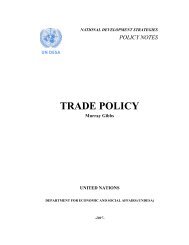National SCP Programmes and Action Plans - Development
National SCP Programmes and Action Plans - Development
National SCP Programmes and Action Plans - Development
Create successful ePaper yourself
Turn your PDF publications into a flip-book with our unique Google optimized e-Paper software.
in the case of Finl<strong>and</strong> as an example can help to engage a wider array of government ministries <strong>and</strong><br />
other stakeholders including civil society <strong>and</strong> business.<br />
Define objectives, targets <strong>and</strong> indicators<br />
The setting of objectives <strong>and</strong> targets is crucial to the success of the programme. Monitoring <strong>and</strong> evaluating<br />
progress towards the programme’s goals is another critical consideration. It provides accountability<br />
for those parties involved <strong>and</strong> demonstrates achievements <strong>and</strong> value of the programme. The UK <strong>and</strong><br />
Japan are among the countries that have set targets <strong>and</strong> are monitoring progress towards these goals.<br />
Integrate with existing national strategies<br />
A <strong>SCP</strong> programme should be an ongoing, flexible <strong>and</strong> iterative process <strong>and</strong> should not simply constitute<br />
a one-off initiative to produce a document. It should also pursue a process of sensitising all existing national<br />
strategies to <strong>SCP</strong> issues <strong>and</strong> integrating relevant components of these strategies where possible.<br />
In some cases this could equate to full integration of the <strong>SCP</strong> programme in a sustainable development,<br />
poverty reduction or other existing strategy. For example, the UK <strong>and</strong> France have included <strong>SCP</strong> as a<br />
priority area in their national sustainable development strategy (NSDS) <strong>and</strong> Ethiopia, Jamaica <strong>and</strong> Mauritius<br />
have done the same in their national environment strategy.<br />
Figure 3: Integration with existing national strategies<br />
Agricultural /<br />
Industrial Policy<br />
<strong>National</strong> <strong>Development</strong><br />
/ Growth Plan<br />
<strong>National</strong> Biodiversity<br />
Strategy <strong>and</strong> <strong>Action</strong><br />
Plan (NBSAP)<br />
<strong>National</strong> Environmental<br />
<strong>Action</strong> Plan (NEAP)<br />
Energy Policy<br />
Health Policy<br />
Forest Policy<br />
Poverty<br />
Reduction<br />
Strategy (PRS)<br />
<strong>SCP</strong><br />
Programme /<br />
<strong>Action</strong> Plan<br />
<strong>National</strong><br />
Sustainable<br />
<strong>Development</strong><br />
Strategy (NSDS)<br />
Climate Change<br />
Strategy<br />
<strong>National</strong> <strong>Action</strong> Plan<br />
to Combat<br />
Desertification (NAP)<br />
Sub-national<br />
strategies<br />
Agenda /<br />
Capacity 21<br />
Population Policy<br />
Education Policy<br />
Transport Policy<br />
Develop sectoral <strong>SCP</strong> action plans<br />
In most countries there are at least some <strong>SCP</strong>-related policies <strong>and</strong> actions that have been implemented,<br />
particularly those related to energy <strong>and</strong> water efficiency <strong>and</strong> waste recycling. Many of these activities are<br />
delivered through existing strategies <strong>and</strong> plans. These ongoing activities <strong>and</strong> the results of a strategic<br />
review will lead to the identification of priority areas for a country’s <strong>SCP</strong> programme. A national <strong>SCP</strong><br />
programme is usually concentrated on a few initial key priority areas, as attempting to address too broad<br />
24
















